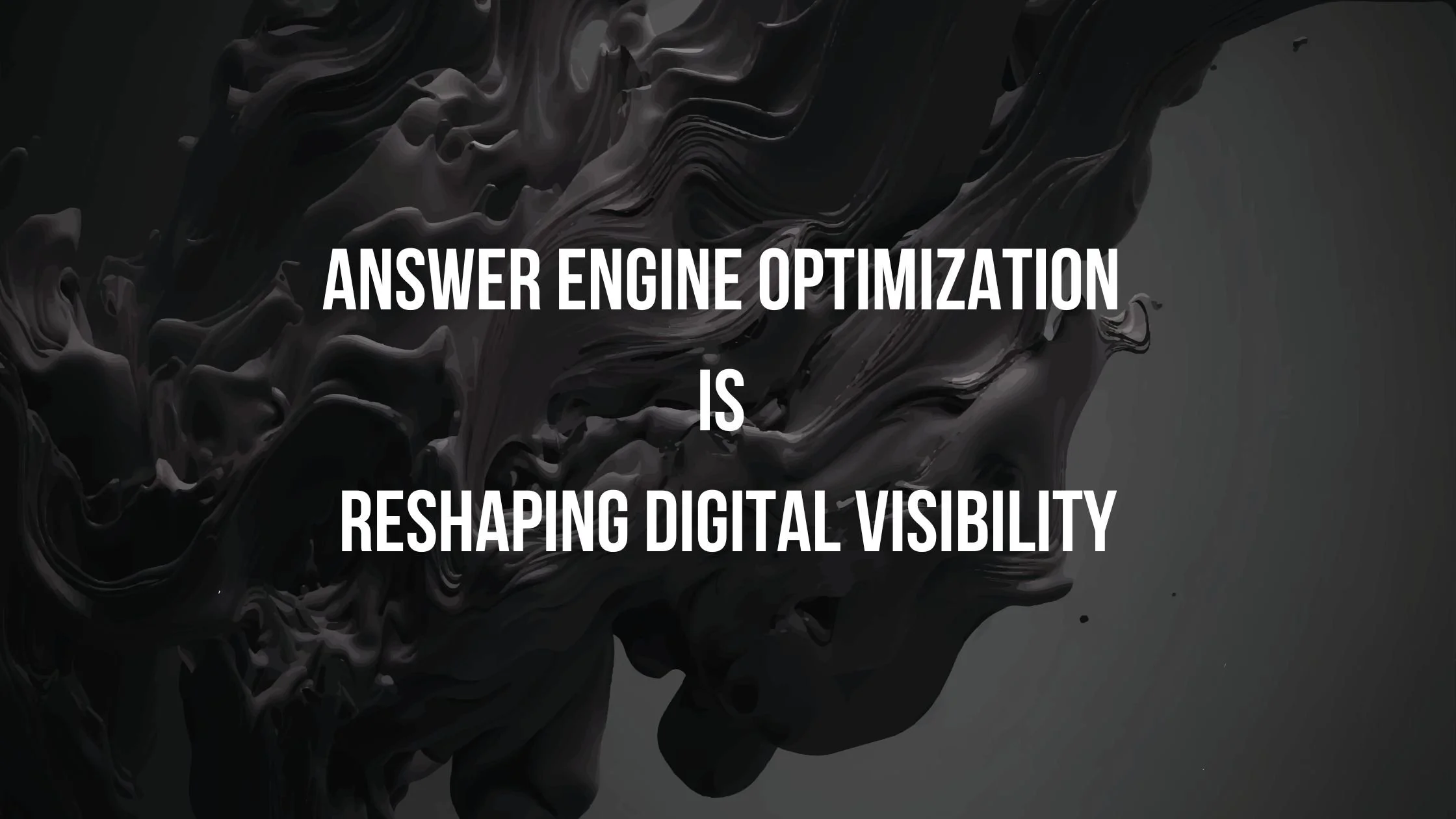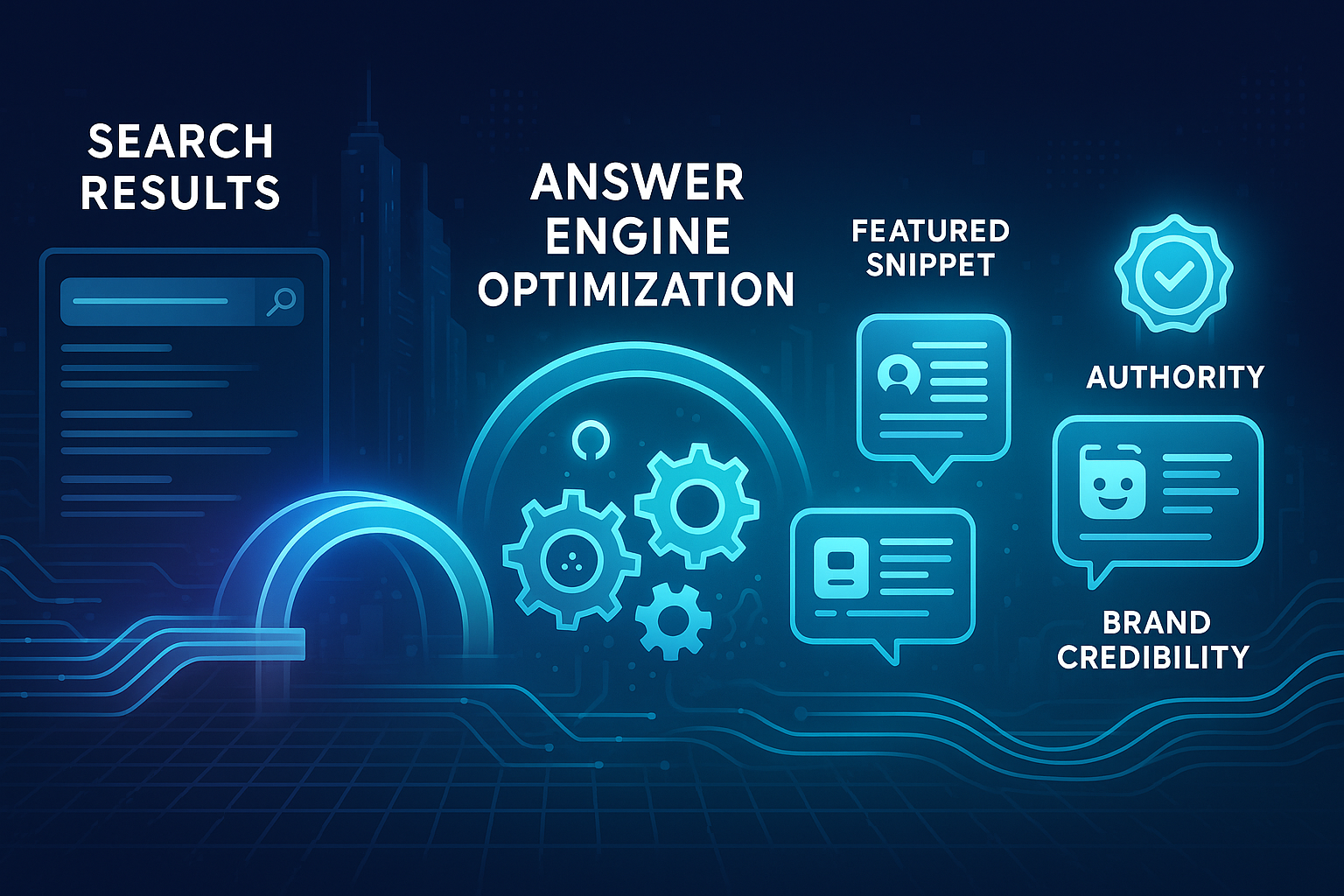Master the Revolutionary Answer Engine Strategy Dominating Search
Answer Engine Optimization (AEO) represents a paradigm shift in digital marketing strategy. As AI-powered search surpasses traditional results pages, your material must adapt to new delivery mechanisms, from featured snippets to voice assistants and AI-generated summaries.
This emerging practice operates as an architect of digital authority, bringing exposure and establishing brand credibility as query results become more solution-centric.
19% of keywords searched on Google result in a featured snippet, in addition to the 7.3% of Search Engine Results Pages that display double-featured snippets, and voice queries account for approximately 27% of all mobile searches.
This transformation in data retrieval makes AEO a central component of digital success, directly influencing everything from brand exposure to user engagement metrics.
The Evolution of Search Optimization Strategy
Digital transformation has altered how businesses approach page optimization. While traditional SEO provided a foundation, today's search requires an advanced understanding of how text performs across platforms, devices, and user interaction models.
This evolution mirrors the broader shift toward intent-driven communication strategy, where every piece of text must balance comprehensive coverage with precise, extractable solutions positioned with what people seek.
Integrating AI into search platforms has introduced new dimensions to page optimization, enabling real-time response generation based on identified user intent patterns.
Businesses leading in digital innovation build structured frameworks that create machine-readable knowledge architectures while maintaining engaging human experiences.
The AI-First Search Revolution
AI-powered platforms now process billions of queries daily, altering how users interact with digital. This evolution demands a strategic approach beyond traditional keyword considerations.
Search interfaces must navigate complex user intents while delivering immediate value and maintaining a brand profile.
Key considerations for AEO strategy include:
Intent refinement for varying query types, from specific questions to conversational exploration
Text performance across different AI platforms, including Google SGE, Microsoft Copilot, and voice assistants
Solution-friendly structures that enhance discovery and provide clear, concise insights
Adaptive frameworks that respond to context and user sophistication levels
Performance enhancement for featured placement without compromising comprehensive value
Strategic AEO Implementation: Beyond Traditional SEO
The strategic development of solution-optimized text has evolved from a creative endeavor to a data-driven discipline backed by intent research and AI response patterns.
AEO integrates a psychological understanding of question formulation with the technical application of structured data, creating frameworks that enhance visibility and authority.
Leading organizations are moving beyond traditional keyword research to implement question-intent mapping systems that respond to people's query patterns and conversational actions.
Primary Text Structures: The Foundation of Solution Discovery
Your page structure is integral to answer engine success. It's like a knowledge scaffold that connects user questions with precise solutions.
Recent studies indicate that structured execution increases featured snippet acquisition by up to 70% across digital platforms.
This attention translates directly into authority and engagement potential.
Strategic considerations for solution structure selection include:
Query pattern analysis relative to competitor material gaps and industry standards
Target demographic search behaviors across different devices and interaction models
Technical requirements for solution extraction across various AI platforms and interfaces
Cross-platform consistency and brand authority metrics
Psychological alignment with question formulation patterns
Cultural significance and market-specific query interpretation
The Question-Solution Framework: Adapting Text for AI Consumption
Contemporary search optimization has evolved beyond rigid keyword placement rules. However, the question-solution framework provides a valuable structure for creating discoverable digital experiences.
This approach has been reimagined for AI environments, incorporating semantic relationships and entity recognition.
Question Elements: Clear interrogative structures across pages
Direct question headings in natural language
FAQ sections with common user queries
Question variations addressing different knowledge levels
Intent-aligned subheadings
Solution Elements: Concise, extractable insight blocks
Direct, summarized responses within 50 words of questions
Supporting evidence and contextual details
Visual supporting elements with proper markup
Citation-worthy, authoritative statements
Context Enhancement: Relationship signals for AI understanding
Entity relationship identification
Semantic markup implementation
Background knowledge frameworks
Topical authority signals
Accessibility and Comprehensiveness in Solution Design
Solution optimization must prioritize inclusive strategies for all users while maintaining depth for AI comprehension. Current best practices establish clear metrics for effective response structures.
However, leading companies push beyond surface-level operations to create fully comprehensive digital experiences.
Comprehensive solution considerations include:
Primary statements within 40-60 words for featured extraction
Secondary contextual insights for a broader understanding
Non-jargon explanations for accessibility across knowledge levels
Alternative conceptual frameworks for principal ideas
Adaptive terminology systems for users with different backgrounds
Regular intent testing and query simulation programs
Voice Search Optimization: The New Essential
The rising adoption of voice interfaces necessitates conversational strategies that maintain brand awareness across interaction preferences. This is more than a technological trend. It's altering how users access digital insights.
Voice optimization strategy:
Conversational text adaptation principles
Natural language pattern implementation
Question-prediction frameworks
Adjusting complexity levels for spoken responses
Preserving accuracy in brief formats
Technical considerations:
Speakable schema markup implementation
Local search refinement
Performance enhancement for mobile interfaces
Cross-platform solution consistency
User experience optimization:
Reduced cognitive load in response structures
Concise, valuable insight delivery
Improved focus and relevance
Enhanced accessibility for diverse users
Strategic Text Implementation
When creating material for answer engines, you need to find the right balance between:
Providing complete insights (comprehensive coverage) - Making sure your text thoroughly addresses the topic and provides sufficient context and details
Making key points easy to extract (extractable precision) - Structuring your pages so that AI systems can identify and pull out direct responses to questions
For example, if you're writing about "how to grow tomatoes," you would include a complete guide with all necessary steps (comprehensive) while also having a clear, direct answer to "When should I plant tomato seeds?" that's easy for an AI to find and extract.
High-Impact Areas for AEO Optimization
Featured Snippet Targeting:
Position zero refinements for maximum positioning in various contexts
Consistent formatting for similar data types across the platform
A/B testing frameworks for continuous solution performance
Dynamic text adaptation based on SERP feature patterns
Heat mapping analysis for effectiveness
Knowledge Graph Integration:
Clear entity relationship implementation for knowledge graph inclusion
Subtle authority building through comprehensive topic coverage
Accessible knowledge architecture across all domains
Mobile-specific considerations for voice interfaces
Visual insight systems for complex concepts
Page Architecture:
Strategic structured data implementation for improved discoverability
Visual hierarchy enhancement through systematic heading application
Balanced depth integration for optimal solution extraction
Dynamic highlighting systems
Entity-relationship knowledge architecture
Modern AEO Tools and Resources
Digital solution management requires highly developed methods that balance creativity with technical precision. Platforms and tools have evolved to meet the complex demands of contemporary search optimization.
Professional AEO Management Solutions:
Schema.org Implementation Tools:
Structured data validation systems
JSON-LD generation frameworks
Microdata implementation assistance
Rich result testing platforms
Cross-platform markup synchronization
Dynamic question discovery with AI assistance
Intent pattern identification tools
Query cluster visualization
Export options for planning
Team collaboration features
Performance Testing Platforms: Comprehensive testing tools for solution strategy validation:
Google Search Console:
Performance tracking for featured snippets
Query analysis for solution material
Search appearance metrics
Enhanced result monitoring
SERPSim:
SERP feature simulation
Multiple device visualization
Cross-platform compatibility
Integration with analysis tools
Measuring AEO Strategy Success
A successful solution strategy requires ongoing monitoring and optimization through metrics and analysis tools.
Key performance indicators:
User Engagement Metrics:
Time spent with featured material
Interaction rates with solution elements
Navigation patterns through structured insights
Mobile vs. desktop effectiveness
Visibility Metrics:
Featured snippet acquisition rates
A/B testing results for solution variations
Voice search appearance frequency
Zero-click search impact analysis
Authority Metrics:
Knowledge graph inclusion metrics
User feedback on solution quality
Cross-channel consistency
Expert citation frequency
The Future of Answer Engine Optimization
The evolution of search optimization continues to accelerate, driven by AI advancements and changing user expectations. Forward-looking businesses must prepare for emerging trends and technologies:
Multimodal solution frameworks that blend text, image, and video responses
Context-aware adaptation based on search history
Personalized insight delivery through machine learning
Enhanced entity relationship mapping across knowledge domains
Interactive solution systems with conversational capabilities
Cross-platform consistency frameworks
Final Thoughts
Success in answer engine optimization requires an ongoing commitment to testing, measurement, and refinement, balanced with unwavering quality and user-centric design principles.
Businesses that master this balance between comprehensive coverage and precise solution delivery will be well-positioned for future visibility.
FAQs
Strategic Understanding
What fundamentally differentiates AEO from traditional SEO?
Answer Engine Optimization transcends traditional SEO's keyword-centric paradigm by prioritizing structured response frameworks designed for AI extraction. While SEO focuses primarily on ranking signals and visibility metrics, AEO operates at the intersection of content architecture, semantic relationships, and intent modeling. This distinction represents an evolution from simply being found to being selected as the authoritative solution source across diverse digital interfaces.
How does AEO impact my existing digital marketing architecture?
AEO functions as a strategic enhancement layer rather than a replacement framework for your current digital ecosystem. It requires integration across content development workflows, technical implementation standards, and performance analytics systems. Organizations typically see AEO driving 30-40% improvements in featured position acquisition within 4-6 months of implementation, with cascading benefits across user engagement metrics, brand authority indicators, and conversion pathways.
What investment timeline should businesses anticipate for AEO implementation?
Developing mature AEO capabilities follows a strategic evolution path, rather than representing a one-time implementation. Organizations should approach this as a phased transformation:
Foundation Phase (1-3 months): Analysis of current answer performance, competitor landscape assessment, and strategic planning
Implementation Phase (2-4 months): Content restructuring, schema markup deployment, and technical optimization
Refinement Phase (Ongoing): Continuous testing, measurement, and adaptation based on AI platform algorithm shifts
Technical Implementation
What structured data formats deliver optimal results for AEO?
The strategic implementation of structured data represents a foundational element of effective AEO. Current best practices prioritize:
JSON-LD format: Providing clear separation between visible content and machine-readable data
Schema.org vocabulary: Focusing particularly on Question, Answer, How To, and FAQ Page schemas
Entity relationship markup: Establishing clear connections between concepts, processes, and organizational entities
Organizations implementing comprehensive structured data strategies report 60-70% higher featured snippet acquisition rates compared to those using basic markup approaches.
How should we balance voice optimization with traditional text-based search?
Voice optimization represents a strategic imperative rather than an either/or proposition. Effective integration requires developing a unified solution framework that adapts presentation based on interface context. This involves:
Identifying high-value voice query patterns through intent modeling
Implementing spoken-optimized response structures (40-60 words) for primary questions
Developing multimodal content assets that function across text, voice, and visual interfaces
Implementing speakable schema markup for voice-priority content segments
Performance Measurement
What metrics most accurately capture AEO performance?
Comprehensive AEO performance measurement requires a multidimensional analytics framework spanning:
Visibility Indicators:
Featured snippet acquisition rate by query category
Knowledge panel inclusion frequency
Voice search response selection rate
Position zero retention duration
Engagement Metrics:
Featured content interaction patterns
Solution path completion rates
Cross-device answer consistency
Zero-click impact assessment
Authority Signals:
Citation frequency in AI-generated responses
Expert validation metrics
Knowledge graph entity relationship strength
Cross-platform authority consistency
How can we effectively benchmark our AEO performance against competitors?
Strategic competitive intelligence for AEO requires analyzing multiple dimensions:
Solution Coverage Analysis: Mapping competitor answer frameworks against your solution architecture
Featured Snippet Competitive Index: Tracking relative performance across high-value query categories
Authority Position Assessment: Measuring comparative expert positioning in knowledge domains
Response Quality Evaluation: Analyzing solution comprehensiveness, accuracy, and extraction-friendliness
Tools like SERP feature tracking platforms, natural language processing analyzers, and semantic relationship mapping systems provide the technical foundation for effective competitive benchmarking.
Strategic Future Planning
How will advancements in generative AI impact AEO strategy?
Generative AI represents both a challenge and opportunity for AEO practitioners. The evolution toward synthesized responses requires strategic adaptation:
Enhanced Attribution Frameworks: Developing citation-worthy content structures that maintain brand visibility
Multimodal Response Optimization: Creating content designed for blended text, visual, and interactive experiences
Context-Aware Solution Design: Implementing adaptive frameworks that anticipate user context variations
Entity Relationship Enhancement: Strengthening knowledge graph connections through comprehensive topic coverage
Organizations that strategically position their content as primary information sources rather than merely visible results will maintain authority as generative interfaces evolve.
What organizational capabilities are required for AEO excellence?
Developing institutional AEO maturity requires cross-functional integration across:
Strategic Capabilities:
Intent research methodology
AI response pattern analysis
Semantic content architecture
Question-solution mapping systems
Technical Capabilities:
Structured data implementation
Natural language processing expertise
Schema optimization frameworks
Cross-platform testing infrastructure
Content Capabilities:
Solution-oriented writing methodologies
Entity relationship modeling
Concise explanation frameworks
Technical accuracy verification
Leading organizations are establishing dedicated AEO centers of excellence to integrate these capabilities into cohesive strategic units.
Implementation Challenges
How can we balance comprehensive coverage with extractable precision?
This fundamental tension in AEO strategy requires architectural thinking rather than content-level compromise. Effective approaches include:
Layered Information Architecture: Creating clear hierarchical relationships between summary solutions and comprehensive exploration
Progressive Disclosure Frameworks: Designing content structures that reveal complexity based on user engagement signals
Entity-Focused Organization: Building content around clearly defined entities with established relationships
Intent-Matched Formatting: Adapting content presentation based on identified user intent patterns
The most successful implementations maintain a consistent 1:4 ratio between extractable solutions and supporting context across their digital ecosystems.
What are the most common pitfalls in AEO implementation?
Organizations frequently encounter challenges in their AEO transformation journey:
Over-optimization for specific platforms rather than developing platform-agnostic solution architectures
Neglecting voice search optimization despite its growing importance across demographic segments
Implementing generic structured data without strategic consideration of entity relationships
Failing to establish clear measurement frameworks that capture true AEO performance
Treating AEO as a technical initiative rather than an integrated strategic discipline
Successful organizations approach AEO as a strategic evolution requiring both technical expertise and fundamental content strategy transformation.
Getting Started
What immediate actions can improve our AEO performance?
Organizations can initiate their AEO journey through targeted strategic interventions:
Conduct a featured snippet audit identifying current performance across high-value query categories
Develop question-intent frameworks for priority knowledge domains
Implement basic structured data markup, focusing on FAQ Page and How To schemas
Create standardized answer structures for consistent solution delivery
Establish baseline performance metrics for ongoing optimization
Even organizations early in their AEO maturity can achieve 15-20% improvements in featured position acquisition through these foundational actions.
How can we stay current with evolving AEO best practices?
The rapidly evolving nature of AI-powered search requires deliberate knowledge acquisition strategies:
Establish a dedicated AEO intelligence function responsible for monitoring platform changes
Develop testing frameworks that evaluate solution performance across diverse interfaces
Participate in knowledge communities focused on semantic search evolution
Create algorithmic change detection systems that identify AI response pattern shifts
Implement continuous learning programs for content and technical teams
Progressive organizations allocate 10-15% of their AEO resources to research and capability development to maintain competitive advantage in this dynamic landscape.



